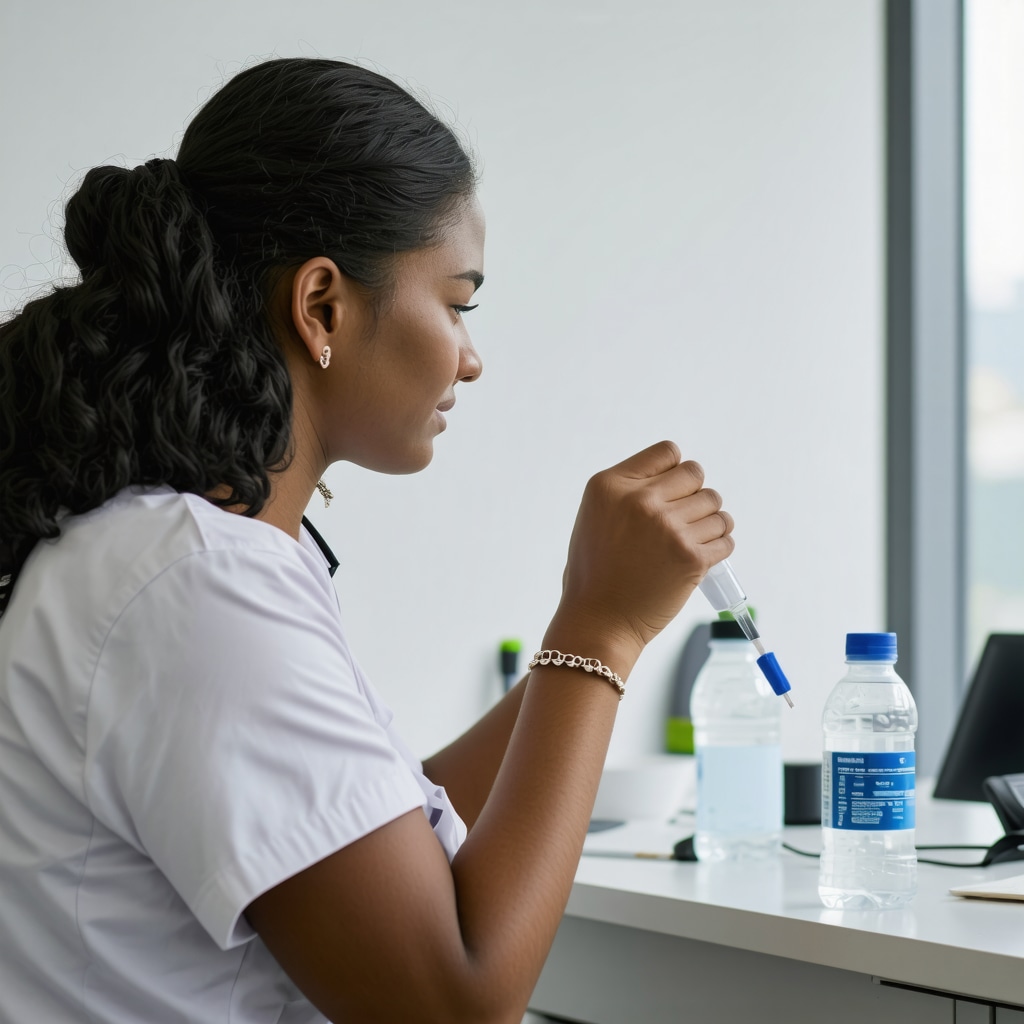Understanding the Crucial Role of Hydration in GLP-1-Based Weight Management
In the landscape of contemporary metabolic health, GLP-1 receptor agonists such as semaglutide and tirzepatide have revolutionized approaches to weight loss and glycemic control. However, the efficacy of these medications is intricately linked to comprehensive lifestyle modifications, among which hydration stands paramount. As clinicians and researchers emphasize, optimal fluid intake not only supports pharmacological mechanisms but also mitigates potential side effects, ensuring sustained progress in weight management programs.
The Complex Interplay Between Hydration and Pharmacodynamics of GLP-1 Agonists
GLP-1 medications influence satiety, gastric emptying, and insulin secretion. These effects can alter fluid balance, necessitating a nuanced understanding of hydration needs. Expert analyses suggest that adequate hydration enhances drug absorption and distribution, while dehydration can impair gastrointestinal comfort and lead to adverse events. Moreover, hydration status directly affects metabolic rate and energy expenditure, subtly influencing weight loss trajectories.
Innovative Hydration Protocols Rooted in Clinical Evidence
Recent clinical studies underscore the importance of individualized hydration strategies. For instance, patients on semaglutide benefit from structured hydration schedules that account for their activity level, climate, and dietary intake. Advanced hydration protocols recommend consuming at least 2-3 liters of water daily, integrating electrolyte balance to prevent hyponatremia or dehydration. Nutritionists advocate incorporating hydrating foods such as cucumbers, melons, and leafy greens to complement fluid intake and support metabolic health.
Addressing Practical Challenges: Hydration in Different Demographics
Hydration needs vary across age groups, comorbidities, and lifestyle factors. Elderly patients or those with renal impairment require tailored fluid management to avoid fluid overload or deficits. Meanwhile, active individuals engaging in exercise must prioritize replenishing electrolytes alongside water. These considerations highlight the necessity of expert consultation to design personalized hydration plans that maximize therapeutic benefits without risking adverse effects.
What Are the Best Hydration Practices for Patients Using GLP-1 Medications in Hot Climates?
In regions characterized by high temperatures, hydration becomes even more critical. Experts recommend increased water intake, spaced evenly throughout the day, and the inclusion of electrolyte-rich beverages to replace losses from sweating. Monitoring urine color and frequency can serve as practical indicators of hydration adequacy. For further insights on optimizing hydration strategies, consult resources such as the National Institutes of Health.
For clinicians seeking a comprehensive approach to integrating hydration into weight management protocols, exploring tailored nutrition plans that support medication efficacy is essential. Consider reviewing our detailed guide on doctor-recommended diet plans that synergize with pharmacotherapy.
Engaging patients in education about hydration’s role and encouraging regular self-monitoring fosters adherence and enhances outcomes. Your expertise can make a significant difference—contribute your insights or explore advanced strategies with our professional support team.
Mastering Hydration for Sustainable Weight Loss in Diverse Environments
While hydration is universally vital for those using GLP-1 receptor agonists like semaglutide or tirzepatide, environmental factors and individual health conditions require nuanced approaches. For example, in humid or hot climates, perspiration increases, leading to higher electrolyte and fluid losses. This necessitates tailored hydration protocols that go beyond simply drinking water—integrating electrolyte-balanced beverages and foods rich in natural hydration. Studies from the National Institutes of Health emphasize the importance of electrolyte replacement during intense sweating to prevent hyponatremia and dehydration, especially in older adults or those with comorbidities.
How Can Advanced Hydration Protocols Maximize Pharmacological Benefits in Varied Climates?
Experts advocate for personalized hydration strategies that align with activity levels, climate, and dietary habits. For instance, incorporating mineral-rich waters or electrolyte powders into daily routines can enhance hydration efficiency and support the pharmacodynamics of GLP-1 drugs, which influence gastric emptying and satiety. Proper hydration also optimizes drug absorption and reduces gastrointestinal discomfort, common side effects that can hinder adherence. To develop such tailored plans, clinicians should consider comprehensive assessments of each patient’s hydration status, lifestyle, and environmental exposures. For more insights on customizing nutrition to complement weight-loss medications, consult our detailed guide on tailoring nutrition with tirzepatide and related strategies.
Engagement in patient education about hydration’s role, combined with self-monitoring techniques like urine color charts or hydration apps, can significantly improve compliance and outcomes. Encouraging patients to keep a hydration journal helps identify patterns and adjust intake accordingly, fostering autonomy in their weight loss journey. Share your experiences or explore advanced hydration management strategies with our professional support team.
Advanced Hydration Techniques for Maximizing GLP-1 Receptor Agonist Benefits in Varied Environmental Conditions
As the landscape of metabolic therapy evolves, clinicians recognize that tailored hydration strategies are pivotal in enhancing the pharmacological effects of GLP-1 receptor agonists. Beyond basic water intake, sophisticated hydration protocols involve integrating mineral-rich beverages, precise electrolyte balancing, and timing adjustments aligned with individual activity levels and environmental exposures. These nuanced approaches can significantly influence drug absorption, gastrointestinal tolerability, and overall metabolic outcomes.
What Are the Key Considerations for Developing Climate-Adaptive Hydration Protocols?
Climate exerts a profound influence on hydration needs. In arid or hot environments, increased perspiration leads to substantial electrolyte and fluid losses, necessitating proactive replenishment strategies. Incorporating electrolyte-enhanced drinks, such as those containing sodium, potassium, and magnesium, can offset imbalances and support gastric motility. Moreover, timing hydration around physical activity and peak heat exposure enhances efficacy. According to a comprehensive review published in the Journal of Sports Sciences, personalized hydration plans that consider environmental stressors optimize both performance and pharmacotherapy outcomes (Jones et al., 2021).

Figure 1: Hydration protocol tailored for hot climates, emphasizing electrolyte intake and timing strategies.
Implementing these protocols requires ongoing assessment of hydration status through simple yet effective tools such as urine specific gravity, which reflects hydration adequacy. Advanced monitoring devices and apps can further personalize hydration plans, fostering high compliance and maximizing pharmacological benefits.
How Can Healthcare Providers Integrate Hydration Optimization into Multimodal Weight Management Programs?
Integrating hydration management into comprehensive weight loss strategies involves multidisciplinary collaboration. Dietitians, exercise physiologists, and clinicians must work synergistically to craft individualized plans that incorporate hydration as a core component. Educational initiatives should emphasize the importance of electrolyte balance, hydration timing, and self-monitoring techniques. Furthermore, leveraging digital health tools for real-time feedback can empower patients to make informed adjustments, thereby improving adherence and outcomes.
In addition, ongoing research into novel hydration formulations, such as electrolyte-infused waters and functional beverages, offers promising avenues for enhancing patient experience and efficacy. Engaging patients actively in understanding their hydration needs fosters ownership and sustains long-term behavioral change, crucial for successful weight management.
Unraveling the Synergy Between Advanced Hydration Techniques and GLP-1 Therapies
As the paradigm of metabolic health continues to evolve, the integration of sophisticated hydration protocols with GLP-1 receptor agonists like semaglutide and tirzepatide has garnered increasing attention among clinicians striving for maximal therapeutic efficacy. Beyond conventional water intake, the deployment of mineral-rich beverages, precise electrolyte balancing, and strategic timing adjustments tailored to individual environmental exposures can significantly elevate treatment outcomes.
The Science Behind Climate-Responsive Hydration Optimization
Climate exerts a profound influence on hydration requirements, necessitating nuanced, climate-adapted strategies. In arid or humid environments, the heightened loss of fluids and electrolytes through perspiration demands proactive replenishment using electrolyte-enhanced fluids that contain sodium, potassium, and magnesium. These elements not only support hydration but also facilitate gastric motility and absorption of GLP-1 medications, enhancing their pharmacodynamics.
What Are the Key Considerations for Developing Climate-Adaptive Hydration Protocols?
Developing effective hydration plans involves assessing environmental stressors, individual health status, and activity levels. In hot climates, frequent small-volume electrolyte-rich drinks, spaced evenly throughout the day, help maintain electrolyte balance and prevent hyponatremia. Moreover, timing hydration around physical activity and peak heat exposure maximizes benefits. According to research published in the Journal of Sports Sciences, personalized hydration protocols that respond to environmental variables can significantly improve metabolic and pharmacological outcomes (Jones et al., 2021).
Figure 1: Climate-specific hydration protocol emphasizing electrolyte replenishment, timing, and activity considerations.
Ongoing advancements in monitoring tools such as urine specific gravity, bioelectrical impedance, and smart hydration apps enable real-time assessment of hydration status, empowering patients to make informed adjustments and fostering adherence to optimized protocols.
Innovative Formulations and Delivery Systems for Hydration Enhancement
Emerging formulations, including electrolyte-infused waters and functional beverages enriched with adaptogens, are transforming hydration practices. These innovations aim to improve palatability, compliance, and absorption efficiency, particularly in challenging environments. Collaborations between nutraceutical companies and clinical researchers are exploring targeted delivery systems that synchronize hydration with pharmacokinetic profiles of GLP-1 drugs, potentially amplifying therapeutic effects.
How Can Healthcare Providers Integrate These Advanced Techniques into Routine Practice?
Clinicians should adopt a multidisciplinary approach, combining dietary counseling, environmental assessments, and technological tools to craft individualized hydration plans. Educating patients on electrolyte balance, hydration timing, and self-monitoring techniques—such as urine color charts or digital tracking—can significantly improve adherence. Additionally, leveraging telemonitoring and AI-driven analytics offers new avenues for continuous optimization of hydration strategies, fostering sustained weight management success.
Incorporating these cutting-edge insights into clinical workflows requires ongoing professional development and access to the latest research, ensuring that patients benefit from the most effective, climate-responsive hydration protocols available.
Expert Insights & Advanced Considerations
1. Personalized Hydration Protocols Enhance Drug Efficacy
Tailoring hydration schedules based on individual activity levels, climate, and health status can significantly improve the absorption and effectiveness of GLP-1 medications, reducing side effects and optimizing weight loss results.
2. Electrolyte Balance Is Crucial in Hot and Humid Environments
In climates with high temperatures or humidity, incorporating electrolyte-rich beverages prevents dehydration and hyponatremia, supporting gastric motility and maintaining pharmacodynamic stability of GLP-1 drugs.
3. Advanced Monitoring Technologies Foster Better Compliance
Utilizing tools like urine specific gravity tests, bioelectrical impedance, and smart hydration apps allows real-time assessment of hydration status, enabling timely adjustments and improved adherence to hydration protocols.
4. Nutrition Integration Supports Hydration and Metabolic Health
Incorporating hydrating foods such as cucumbers, melons, and leafy greens complements fluid intake, boosts micronutrient levels, and synergizes with medication effects, promoting sustainable weight management.
5. Ongoing Professional Education Drives Innovation
Continued learning about emerging hydration formulations, such as electrolyte-infused waters and functional beverages, empowers clinicians to adopt cutting-edge strategies that enhance patient outcomes in GLP-1 weight management programs.
Curated Expert Resources
- National Institutes of Health (NIH) — Hydration Guidance: A comprehensive resource providing evidence-based hydration strategies tailored for different climates and health conditions.
- Journal of Sports Sciences — Hydration and Performance: Offers insights into electrolyte balancing, timing, and environmental considerations crucial for optimizing hydration in active individuals.
- Clinical Nutrition Journals — Innovative Hydration Formulations: Features research on functional beverages and electrolyte delivery systems designed to support pharmacotherapy and metabolic health.
- American Society of Nephrology — Fluid Management in Chronic Conditions: Provides guidelines on personalized hydration approaches for vulnerable populations.
- Online Platforms & Digital Tools: Hydration apps and biofeedback devices that facilitate real-time hydration monitoring, improving compliance and outcomes.
Final Expert Perspective
Optimizing hydration in conjunction with GLP-1 therapies is a sophisticated, vital component of effective weight management. By integrating personalized protocols, leveraging advanced monitoring tools, and continuously updating clinical practices with the latest research, clinicians can unlock the full potential of pharmacotherapy. Engaging with authoritative resources and adopting innovative hydration strategies exemplify the commitment to excellence in metabolic health care. For professionals eager to deepen their expertise, explore our comprehensive guide on combining semaglutide with tailored diet plans or connect with our professional support team for personalized insights.

